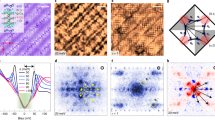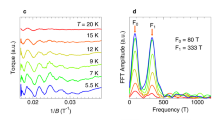Abstract
A central question in the study of high-temperature superconductivity is whether this phenomenon is linked to the doped antiferromagnetic Mott insulator or whether it emerges from a Fermi-liquid state across the whole cuprate phase diagram. Discriminating between these orthogonal cases hinges on the quantitative determination of the elusive quasiparticle strength Z as a function of hole-doping p, from the heavily overdoped to the deeply underdoped regime. Here we show, by means of angle-resolved photoemission spectroscopy and an in situ doping technique, that the electronic structure of the overdoped metal (0.24≤p≤0.37) is in remarkable agreement with density functional theory and Fermi-liquid-like descriptions. However, below p≈0.10–0.15, we observe the loss of nodal quasiparticle integrity. This marks a clear departure from Fermi-liquid behaviour and a more rapid than expected crossover to Mott physics, indicating that the physical properties of underdoped cuprates are dominated by incoherent excitations.
This is a preview of subscription content, access via your institution
Access options
Subscribe to this journal
Receive 12 print issues and online access
$209.00 per year
only $17.42 per issue
Buy this article
- Purchase on Springer Link
- Instant access to full article PDF
Prices may be subject to local taxes which are calculated during checkout




Similar content being viewed by others
References
Zaanen, J., Sawatzky, G. A. & Allen, J. W. Band gaps and electronic structure of transition-metal compounds. Phys. Rev. Lett. 55, 418–421 (1985).
Chen, C. T. et al. Electronic states in La2−xSrxCuO4+δ probed by soft-X-ray absorption. Phys. Rev. Lett. 66, 104–107 (1991).
Meinders, M. B. J., Eskes, H. & Sawatzky, G. A. Spectral-weight transfer: Breakdown of low-energy-scale sum rules in correlated systems. Phys. Rev. B 48, 3916–3926 (1993).
Kohsaka, Y. et al. An intrinsic bond-centred electronic glass with unidirectional domains in underdoped cuprates. Science 315, 1380–1385 (2007).
Peets, D. C. et al. X-ray absorption spectra reveal the inapplicability of the single-band Hubbard model to overdoped cuprate superconductors. Phys. Rev. Lett. 103, 087402 (2009).
Anderson, P. W. The resonating valence bond state in La2CuO4 and superconductivity. Science 235, 1196–1198 (1987).
Doiron-Leyraud, N. et al. Quantum oscillations and the Fermi surface in an underdoped high-Tc superconductor. Nature 447, 565–568 (2007).
Sebastian, S. E. et al. Fermi liquid behaviour in an underdoped high-Tc superconductor. Phys. Rev. B 81, 140505(R) (2010).
Comanac, A., de Medici, L., Capone, M. & Millis, A. J. Optical conductivity and the correlation strength of high temperature copper-oxide superconductors. Nature Phys. 4, 287–290 (2008).
Sachdev, S. Where is the quantum critical point in the cuprate superconductors? Phys. Status Solidi B 247, 537–543 (2010).
Chakravarty, S. Key issues in theories of high-temperature superconductors. Preprint at http://arxiv.org/abs/1006.4180 (2010).
Hossain, M. A. et al. In situ doping control of the surface of high-temperature superconductors. Nature Phys. 4, 527–531 (2008).
Andersen, O. K., Liechtenstein, A. I., Jepsen, O. & Paulsen, F. LDA energy bands, low-energy Hamiltonians, t′, t′′, t⊥(k), and j⊥ . J. Phys. Chem. Solids 56, 1573–1591 (1995).
Carrington, A. & Yelland, E. A. Band-structure calculations of Fermi-surface pockets in ortho-II YBa2Cu3O6.5 . Phys. Rev. B 76, 140508(R) (2007).
Elfimov, I. S., Sawatzky, G. A. & Damascelli, A. Theory of Fermi-surface pockets and correlation effects in underdoped YBa2Cu3O6.5 . Phys. Rev. B 77, 060504(R) (2008).
Pasanai, K. & Atkinson, W. A. Theory of (001) surface and bulk states in Y1−yCayBa2Cu3O7−d . Phys. Rev. B 81, 134501 (2010).
Imada, M., Fujimori, A. & Tokura, Y. Metal–insulator transitions. Rev. Mod. Phys. 70, 1039–1263 (1998).
Anderson, P. W. et al. The physics behind high-temperature superconducting cuprates: the ‘plain vanilla’ version of RVB. J. Phys.: Condens. Matter 16, R755–R769 (2004).
Yang, K. Y., Rice, T. M. & Zhang, F. C. Phenomenological theory of the pseudogap state. Phys. Rev. B 73, 174501 (2006).
Haule, K. & Kotliar, G. Strongly correlated superconductivity: A plaquette dynamical mean-field theory study. Phys. Rev. B 76, 104509 (2007).
Civelli, M. et al. Nodal–antinodal dichotomy and the two gaps of a superconducting doped Mott insulator. Phys. Rev. Lett. 100, 046402 (2008).
Vidhyadhiraja, N. S., Macridin, A., Şen, C., Jarrell, M. & Ma, M. Quantum critical point at finite doping in the 2D Hubbard model: A dynamical cluster quantum Monte Carlo study. Phys. Rev. Lett. 102, 206407 (2009).
Damascelli, A. Probing the electronic structure of complex systems by ARPES. Phys. Scr. T109, 61–74 (2004).
Damascelli, A., Hussain, Z. & Shen, Z-X. Angle-resolved photoemission spectroscopy of the cuprate superconductors. Rev. Mod. Phys. 75, 473–541 (2003).
Campuzano, J. C, Norman, M. R. & Randeria, M. Photoemission in the High-Tc Superconductors Vol. II, 167–265 (Springer, 2004).
Kanigel, A. et al. Evolution of the pseudogap from Fermi arcs to the nodal liquid. Nature Phys. 2, 447–451 (2006).
Chatterjee, U. et al. Observation of a d-wave nodal liquid in highly underdoped Bi2Sr2CaCu2O8+δ . Nature Phys. 6, 99–103 (2010).
Shen, Z.-X. & Sawatzky, G. A. Novel electronic structure of cuprate superconductors revealed by the anomalous spectral lineshape in ARPES experiments. Phys. Status Solidi B 215, 523–529 (1999).
Feng, D. L. et al. Signature of superfluid density in the single-particle excitation spectrum of Bi2Sr2CaCu2O8+δ . Science 289, 277–281 (2000).
Ding, H. et al. Coherent quasiparticle weight and its connection to high-Tc superconductivity from angle-resolved photoemission. Phys. Rev. Lett. 87, 227001 (2001).
Kaminski, A. et al. Crossover from coherent to incoherent electronic excitations in the normal state of Bi2Sr2CaCu2O8+δ . Phys. Rev. Lett. 90, 207003 (2003).
Platé, M. et al. Fermi surface and quasiparticle excitations of overdoped Tl2Ba2CuO6+δ by ARPES. Phys. Rev. Lett. 95, 159–168 (2005).
Peets, D. C. et al. Tl2Ba2CuO6+δ brings spectroscopic probes deep into the overdoped regime of the high-Tc cuprates. New J. Phys. 9, 28 (2007).
Lin, H., Sahrakorpi, S., Markiewicz, R. S. & Bansil, A. Raising Bi–O bands above the Fermi energy level of hole-doped Bi2Sr2CaCu2O8+δ and other cuprate superconductors. Phys. Rev. Lett. 96, 097001 (2006).
Shen, K. M. et al. Nodal quasiparticles and antinodal charge ordering in Ca2−xNaxCuO2Cl2 . Science 307, 901–904 (2005).
Lee, W. S. et al. Abrupt onset of a second energy gap at the superconducting transition of underdoped Bi2212. Nature 450, 81–84 (2007).
Graf, J. et al. Universal high energy anomaly in the angle-resolved photoemission spectra of high temperature superconductors: possible evidence of spinon and holon branches. Phys. Rev. Lett. 98, 067004 (2007).
Hüfner, S., Hossain, M. A., Damascelli, A. & Sawatzky, G. A. Two gaps make a high-temperature superconductor?. Rep. Prog. Phys. 71, 062501 (2008).
Dimov, I., Goswami, P., Jia, X. & Chakravarty, S. Competing order, Fermi surface reconstruction, and quantum oscillations in underdoped high-temperature superconductors. Phys. Rev. B 78, 134529 (2008).
Audouard, A. et al. Multiple quantum oscillations in the de Haas–van Alphen spectra of the underdoped high-temperature superconductor YBa2Cu3O6.5 . Phys. Rev. Lett. 103, 157003 (2009).
Garcia-Aldea, D. & Chakravarty, S. Multiple quantum oscillation frequencies in YBa2Cu3O6+δ and bilayer splitting. Preprint at http://arxiv.org/abs/1003.2665 (2010).
Ramshaw, B. J. et al. Spin-zeros in quantum oscillations in YBa2Cu3O6.59 limit the role of electron spin order in the pseudogap phase of high temperature superconductors. Preprint at http://arxiv.org/abs/1004.0260 (2010).
Sénéchal, D. & Tremblay, A-M. S. Hot spots and pseudogaps for hole- and electron-doped high-temperature superconductors. Phys. Rev. Lett. 92, 126401 (2004).
Maier, T., Jarrell, M., Pruschke, T. & Hettler, M. H. Quantum cluster theories. Rev. Mod. Phys. 77, 1027–1080 (2005).
Phillips, P. Colloquium: Identifying the propagating charge modes in doped Mott insulators. Rev. Mod. Phys. 82, 1719–1742 (2010).
Lee, Y. S. et al. Electrodynamics of the nodal metal in weakly doped high-Tc cuprates. Phys. Rev. B 72, 054529 (2005).
Acknowledgements
We gratefully acknowledge W. A. Atkinson, J. P. Carbotte, D. Munzar, M. R. Norman, G. A. Sawatzky, T. Senthil and D. van der Marel for discussions. This work was supported by the Killam Program (A.D.), the A. P. Sloan Foundation (A.D.), the CRC Program (A.D.), NSERC, CFI, CIFAR Quantum Materials and BCSI. The Advanced Light Source is supported by the Director, Office of Science, Office of Basic Energy Sciences, of the US Department of Energy under Contract No. DE-AC02-05CH11231.
Author information
Authors and Affiliations
Contributions
D.F. and A.D. conceived this investigation and are responsible for data analysis and interpretation. D.F. and G.L. carried out the ARPES experiments, with the assistance of J.L.M., A.B. and E.R. for the work at ALS. Y.P. carried out the STM experiments. R.L., W.N.H. and D.A.B. fabricated and characterized the samples. I.S.E. carried out the density functional theory calculations. All of the authors discussed the underlying physics and contributed to the manuscript. A.D. was responsible for overall project direction, planning, and management.
Corresponding authors
Ethics declarations
Competing interests
The authors declare no competing financial interests.
Supplementary information
Supplementary Information
Supplementary Information (PDF 325 kb)
Rights and permissions
About this article
Cite this article
Fournier, D., Levy, G., Pennec, Y. et al. Loss of nodal quasiparticle integrity in underdoped YBa2Cu3O6+x. Nature Phys 6, 905–911 (2010). https://doi.org/10.1038/nphys1763
Received:
Accepted:
Published:
Issue Date:
DOI: https://doi.org/10.1038/nphys1763
This article is cited by
-
Unveiling phase diagram of the lightly doped high-Tc cuprate superconductors with disorder removed
Nature Communications (2023)
-
Momentum-resolved visualization of electronic evolution in doping a Mott insulator
Nature Communications (2021)
-
Emergent charge order from correlated electron-phonon physics in cuprates
Communications Physics (2020)
-
Emergence of quasiparticles in a doped Mott insulator
Communications Physics (2020)
-
Nematic fluctuations in the cuprate superconductor Bi2Sr2CaCu2O8+δ
Nature Communications (2019)



